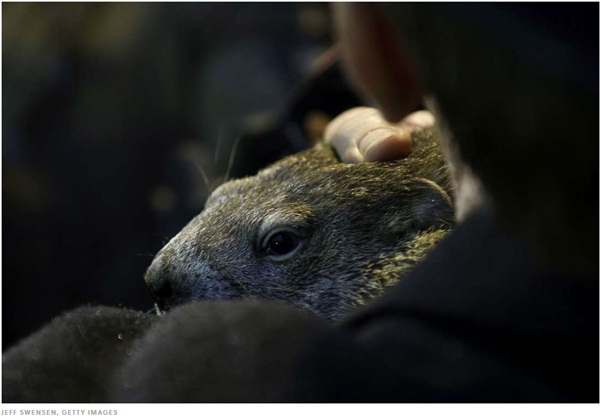美国人为什么用土拨鼠来预测天气?
这个冬天格外寒冷,谁也不知道温暖的春天何时才会来临。在美国,如果人们想知道冬天还会持续多久,就会在2月2日这天看一只土拨鼠能不能看到自己的影子。人们为什么会认为土拨鼠能预测天气?这只土拨鼠预测得准不准呢?
|

Mental Floss网站截图 |
It's only been in the past 60 or so years that humans have been able to rely on television meteorologists for weather predictions. Before Al Roker, the Babylonians looked at cloud formations; in 300 BC, the Chinese had a calendar broken into 24 festivals, each with its own unique weather patterns.
直到大约60年前,人类才得以通过看电视上的天气预报来预知天气。在有美国气象播报员阿尔·洛克之前,巴比伦人是通过观看云体形成来预知天气的;在公元前300年,中国人将一年分成24个节气,每个节气都有各自独特的气候模式。
Today we use satellites and other costly equipment to gauge our environment, examining changes in the atmosphere and running sophisticated computer models. And sometimes, we just stare at a groundhog.
今天我们用人造卫星和其他昂贵的设备来监测我们的环境、气候的改变并运行精密的计算机模型。不过有时候,我们只看土拨鼠来预知天气。
Every February 2, a doughy rodent named Punxsutawney Phil briefly emerges from his winter hibernation to have a look around. If he sees his shadow, that means there will be six more weeks of winter. If he doesn't, we can assume that warm weather is looming.
每年2月2日,一只名叫庞克瑟托尼·菲尔的软乎乎的土拨鼠会从冬眠的洞里露出头来四下看一看。如果它看到了自己的影子,那就意味着冬天还要持续6周。如果它没看到自己的影子,我们就可以假定温暖的天气即将来临。
The ritual has been carried out in Punxsutawney, Pennsylvania every year since 1887. Relying on Phil is actually not much better than flipping a coin—he's right an estimated 64.4 percent of the time—but clearly someone at one time believed a groundhog had predictive abilities. Who? And why?
自1887年以来,这一仪式每年都要在美国宾夕法尼亚州的庞克瑟托尼举行。事实上,靠菲尔来预测天气的成功率不比抛硬币高多少——这只土拨鼠预测天气的准确率约为64.4%——但显然有人曾一度认为土拨鼠有预测天气的能力。是谁呢?为什么会这么认为?
To understand Phil's current status, it helps to know that superstition and weather have had a long association. Observers of the Christian holiday Candlemas, for example, received candles blessed by clergymen. If the skies were cloudy that day, warm weather was imminent; if the sun was out, winter would persist.
要明白菲尔目前的身份,最好能了解迷信和天气之间长久以来的关联。举例来说,基督教信徒在圣烛节会收到牧师祝福过的蜡烛。如果圣烛节那天是多云,说明温暖的天气很快就要来到;如果太阳出来了,冬天将会持续下去。
In Europe, the idea that winter's duration could be foretold was carried over to animal behavior. Hibernating animals like bears, marmots, and hedgehogs were observed to see when they'd emerge from their dens.
在欧洲,预测冬天持续时间和动物行为扯到了一起。人们会观察熊、旱獭、刺猬等冬眠动物,看它们会不会从洞里出来。
In Germany, the weather was anticipated by badgers. When Germans began settling in Pennsylvania, however, badgers weren't so readily available: The easiest hibernating animal to locate was the groundhog. In 1887, a newspaper editor began circulating the idea that one groundhog in particular, Punxsutawney Phil, was a meteorological wonder. Before long, the entire country became preoccupied with Phil’s prognosticating, and an annual tradition was born.
在德国,天气是由獾来预测的。但是,当德国人在美国宾夕法尼亚州定居的时候,獾并没有那么好找:最容易找到的冬眠动物是土拨鼠。1887年,一位报社编辑开始传播一个信息:有一只名叫庞克瑟托尼·菲尔的土拨鼠是预测天气的奇才。没过多久,整个国家都被菲尔的预测迷住了,一项年度传统就此诞生。
Phil isn't the only one in the business of long-range forecasting. The Old Farmer's Almanac, a yearly digest of upcoming weather patterns for large geographical areas, is prepared up to 18 months in advance: Its editors claim an 80 percent accuracy rate, though some meteorologists dispute the viability of assessing weather more than two weeks out.
从事长期天气预报的不只有菲尔。《老农民年历》是一本预测大范围地区天气的年度出版物,每年都是提前18个月准备。这本年历的编辑声称准确率有80%,尽管一些气象学家质疑提前两周以上预测天气是否可行。
Last year, Phil "predicted" six more weeks of winter. It turned out to be the second-warmest February on record.
去年,菲尔“预测”冬天还将持续6周。结果,去年二月份的天气是有史以来最暖和的。
- 相关文章
随机文章













